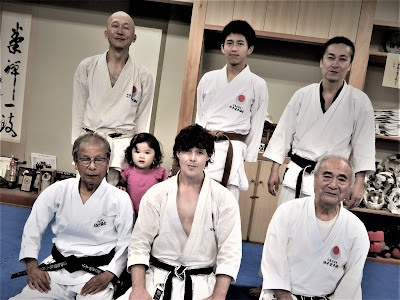 |
| The direction of your toes doesn't have to be 'perfect'; however, perfection must always be sought after in daily training. |
A
very important aspect, especially in regards
to unsoku/ashi-hakobi, is ‘TOE DIRECTION’. This is not only about external form
but optimal efficiency, angle of movements and, consequently, transfer of
power.
Besides intention, spirit,
trajectory, and positioning: the power in the Karate-Do I practise, and teach,
is ‘generically derived’ from four main sources:
1) Propulsion / Transferring of weight: via moving
the body;
2) Compression and expansion – vertical power;
3) Rotation of the hips/waist –horizontal power;
and,
4) Relaxation: and resulting ‘snap’ of techniques.
Toe direction is especially important for ‘propulsion/transferring of weight:
via moving; but almost equally as important when comes to rotation of the
hips/waist: as it is one of the keys to perfectly coordinate the upper, middle,
and lower sections of the body; in particular, the ‘harmonious twisting’ of the
ankles and hips.
Above and beyond this point is that, here in Japan,—the advanced method
employed by the more elite practitioners—is
close-guarded or, as the saying goes, ‘kept in-house’.
Obviously, mastery and continuous practise of this imperative aspect of Kihon
is vitally important: if one is seeking maximise the effect of ‘martial arts
karate’ techniques.
I'd like to conclude with an encouraging point… For many karateka, especially
non-Japanese practitioners, directing their toes correctly is particularly
troublesome. The good thing is that this can be overcome by knowing where, and
how, to use ones power: especially by using the aforementioned elite method. More
than anything else, this relates to the correct use of kakato (kakuto
chushin)—heel centralisation/centreline and tsumasaki—the toes of the opposite foot
when moving.
In
this context this ‘fundamental’ doesn’t only relate to coordination but, again,
as mentioned above, weight transfer.
Hence,
‘snap’ can be made by the lower and upper body and, simultaneously, maximum
bodyweight can be applied: the ideal mix of heavy and light, hard and soft.
Once karateka can do this, they can move on to much more advanced aspects.
My plan this year has been to include this aspect then within my teaching
schedule and, then next year, we will begin to go well beyond this (and other
vital elements). Overall, 2017 has been, and continues to be—a technical
springboard for 2018 and, indeed, into the future. My best wishes to everyone
here in Japan, and around the world, from an increasingly hot and humid Oita
Prefecture.
押忍, アンドレ
©
Andre Bertel. Oita-City, Japan (2017).








